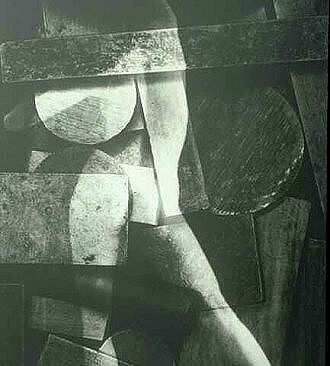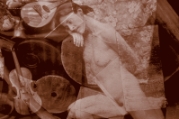![]()
Nicholas
Fox Weber, Executive Director, Josef & Anni Albers Foundation, The Witkin
Gallery, March 1996
 The
word "lyricism" pertains to Victor Friedman's latest work, but it is a
lyricism with weight, built on a solid foundation. The ambient gentleness is
grounded in substance and grit; the softness is bold.
The
word "lyricism" pertains to Victor Friedman's latest work, but it is a
lyricism with weight, built on a solid foundation. The ambient gentleness is
grounded in substance and grit; the softness is bold.
Sensuous
nudes and luminous pitchers and vials interact with rough-cut chunks of metal.
These amazing juxtapositions occur in pale ivories and browns that radiate a
muted pink. Blossoms arranged as if by Redon sing their quiet tune against a
metal relief that evokes Schwitters’ junkyard fantasies.
Yet these sculptural photographs--media blends, musical still-lifes--we don't quite know what to call them--resemble no one else's work. We feel the same excitement offered by Synthetic Cubism and enjoy its themes of domestic beauty, but the approach is completely imaginative. With their vocabulary of guitars and mandolins, flowered fabric and ripe fruit, Friedman's constructions provide the sensuous well-being so essential to Braque and Picasso and Gris in that era when life was to be savored in all its bounty and nuance--but his pioneering images do it in a new way.
These
well organized yet seemingly spontaneous amalgams derive from Friedman's particular and personal manipulations of the photographic process. The technique
achieves astounding richness and a vibrant interplay of three-dimensional
layering with a highly charged surface. Airy, weightless forms--metal blocks
transformed to total lightness--interact in lively syncopation. To explain it
all--either visually or scientifically--is nearly impossible; in any event, it
is beside the point. For the effect of the art exceeds the components that made
it work.
particular and personal manipulations of the photographic process. The technique
achieves astounding richness and a vibrant interplay of three-dimensional
layering with a highly charged surface. Airy, weightless forms--metal blocks
transformed to total lightness--interact in lively syncopation. To explain it
all--either visually or scientifically--is nearly impossible; in any event, it
is beside the point. For the effect of the art exceeds the components that made
it work.
Friedman's
images are mysterious in a gentle and enticing way. They suggest the richness of
disarray that is under control, and the wonder of veils. The sensibility behind
them is both courageous and gentle--exhilarating rather than threatening. Here
we look at the New York of dancers/artist models and construction waste heaps as
seen and re-formed by a master of his craft who is refined, erudite, and daring.
The artistic results are translucent, provocative and deeply satisfying.
![]()
Mary Cummings, The Southhampton Press, December 19, 1991
Victor
Friedman doesn't deny that he uses a camera to create the haunting images in
black and white that will hang at Canio’s Books in Sag Harbor through January
4. They are indeed photographs, these evocative visions in which female figures,
bathed in lovely, muted, natural light, take on the textural variations of
objects superimposed on them, or vice versa, to such mysterious, otherworldly
effect.
 “Drawn
figures always attracted me,” he says, and indeed, the photos he has readied
for the Canio show hit the senses with the same evocative power that some of the
best black and white drawings possess. (One that comes immediately to mind is
Georges Seurat’s of his mother, a gem of the current show at the Metropolitan
Museum, in which the figure of a woman sewing emerges out of the shadows of
another era.)
“Drawn
figures always attracted me,” he says, and indeed, the photos he has readied
for the Canio show hit the senses with the same evocative power that some of the
best black and white drawings possess. (One that comes immediately to mind is
Georges Seurat’s of his mother, a gem of the current show at the Metropolitan
Museum, in which the figure of a woman sewing emerges out of the shadows of
another era.)
The
point is, when Mr. Friedman undertakes to bring form to his vision, the camera
work is simply one part of the process—and not necessarily the most important
one, he suggests. His real creative task, as he explains it, involves sculpting
an image, composing its parts, manipulating them to give them relief, texture
and meaning. It happens that he combines the elements of his image and creates
his illusions photographically, with the help of some inventive work in the
darkroom.
Mr. Friedman doesn’t talk much about lenses, exposures and the mechanics of taking pictures. He prefers an artistic vocabulary drawn from virtually every medium but photography.
He
first tried his hand as a "street photographer," he recalls, but
almost immediately there was this "urge to do the figure." With
hindsight, it seems inevitable that anyone who uses the female figure to such
poetic and sensuous effect would take that direction. When he did, the decision
immediately raised the whole enterprise to new levels of intensity.
He
has progressed to bigger prints, better cameras. He has experimented with his
images, toning them, scraping, cutting them up, putting negatives together. He
has a New York dealer, The Witkin Gallery, at 415 West Broadway, and he is planning a new series with even bigger dimensions and more complex collage
techniques.
![]()
Three
Village Herald, March 7, 1990
"The Photographer's Lens at Gallery North," by Susan Bridson
These photographs are photo-journalism at their respective best. Victor Friedman uses a large field for his towering silver prints, "Figure with Violin," "Two Figures with Violin and Lute," and "Two Figures." These deft creations are so textured and composed that they require a second look, and a third, before we are sure these are not Cubist paintings. There is wizardry in Friedman's touch.
![]()
The Three Village Herald, June 23, 1999.

Victor Friedman's Nova Scotia portfolio is as a zoom lens on the hard scrabble
lives which some Canadians eke out there. "Cleaning Berries" tugs at
the heart with vivid cinema verite -- a contrast to the blazingly white church
so characteristic of Nova Scotia. And that blacksmith's face cannot be
beat.
![]()
Philadelphia
City Paper, July 19, 1985
"Victor Friedman: Photographs, the Philadelphia Art Alliance"
The
black and white photographs by Victor Friedman on display there are worth
visiting for themselves. A good proportion are of the Burk Uzzle genre, in which
exhibitionistic subjects reveal more than they intend, or just plain American
folks wind up looking oddly kinky. Other of Friedman's pictures are social or
ethnically conscious with sentimental overtones. The series from the Lubovitch
Hasidic Synagogue is especially rich in traditional imagery. Friedman's
prints have a romantically dark tonality.
![]()
